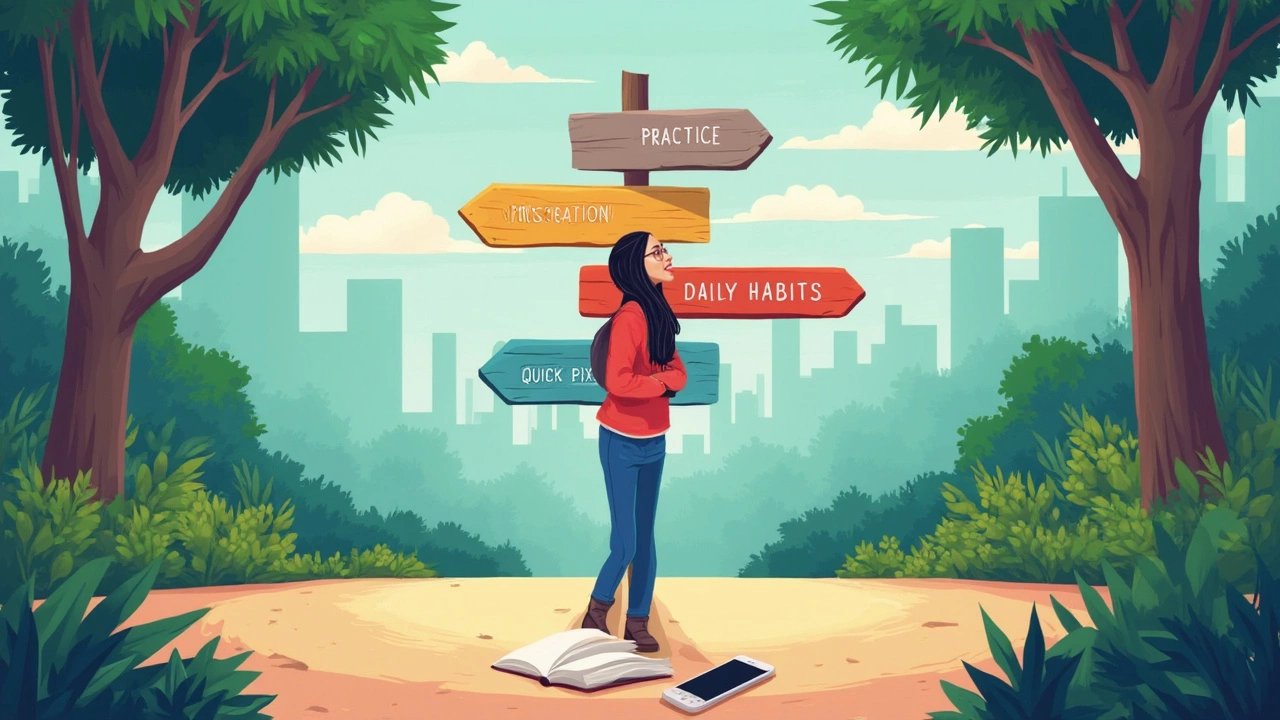So, you want to know exactly how many days it'll take before you can chat in English without breaking a sweat—yeah, who doesn’t? You’ve probably seen those ads shouting, 'Speak English in 30 days!' Sounds great, but can anyone honestly promise that?
Here’s the thing—everybody’s brain works differently. How fast you’ll get fluent isn’t just about how many hours you cram into a course. Your daily habits, how much you actually use English, and what ‘fluently’ even means to you… all of that changes the game completely.
Let’s get one thing straight: memorizing grammar rules for a month doesn’t make you ready for real conversations. Most people start out thinking it’s all about how many new words they can swallow every day, but fluency is more about getting comfortable using the words you already know—again and again—so you don’t need to think about them.
You want a quick trick? Try talking to your mirror every single day. Or find online buddies for video chats. This kind of practice beats writing out vocabulary lists, because it forces your brain to work in real time.
- The Myth of '30 Days to Fluency'
- What Fluency Really Means
- What Actually Affects Your Progress
- Daily Practice: What Works and What Doesn’t
- When Will You Finally Feel Fluent?
The Myth of '30 Days to Fluency'
If you search the web for ways to learn English, you’ll run into a ton of promises like, “Speak fluently in 30 days.” It sounds awesome—a month from now, you’re chatting like a native, right? Real talk: no official study or language expert agrees with this. There’s actually zero scientific proof that anyone starting from scratch can reach true fluency so fast.
Let’s look at a known fact: The Common European Framework of Reference for Languages (CEFR)—which is used by thousands of language schools worldwide—defines fluency levels from A1 (beginner) to C2 (almost like a native). Here’s what real data says about how long it takes to move up the levels if you study seriously:
| CEFR Level | Approximate Hours Needed |
|---|---|
| A1 to A2 | 100-120 |
| A2 to B1 | 180-200 |
| B1 to B2 | 200-220 |
| B2 to C1 | 250-300 |
| C1 to C2 | 300+ |
Even if you grind out three hours every single day, you’d still need months to reach the level where you really feel confident speaking English about anything with anyone. That’s assuming you’re using smart methods and practicing out loud, not just passively watching videos.
If someone sells a 'shortcut,' ask if they mean memorizing a script or actually being able to have a conversation about real-life stuff. Most “English fluency timeline” marketing skips the part where real fluency needs both speaking practice and time for your brain to adjust.
- Some courses teach you just enough to order coffee or book a hotel—handy, but that’s not true fluency.
- Adult language learners, on average, need at least 600-750 hours of active study and practice to get comfortable in everyday conversations.
- Kids seem to pick it up faster because they use the language all day; most adults have way less exposure.
You don’t have to chase magic numbers. Focus on steady, daily work, and don’t panic if 30 days comes and goes. It’s totally normal.
What Fluency Really Means
People throw around the word “fluency,” but what does it actually look like? It’s not about speaking perfect English or knowing every word in the dictionary. Real fluency means you can express your ideas clearly, understand others easily, and keep a conversation going—even if you make a few mistakes along the way.
Here’s how you know you’re on the right track: if you can handle daily stuff like ordering food, asking for directions, or chatting with a coworker without having to translate every single word in your head, that’s real progress. Being ‘fluent’ just means you don’t freeze or panic when someone speaks to you in English.
Check out these common features that most experts use when talking about fluency:
- Talking smoothly, without long pauses or getting stuck every few seconds
- Understanding what people say—especially native speakers—at regular speaking speed
- Making yourself clear even if you use simple words
- Fixing your mistakes on the fly without losing your train of thought
You don’t have to sound like a BBC news anchor. In fact, studies show that even fluent speakers mess up sometimes. A 2021 Cambridge study found that most adult learners reach conversational fluency after putting in about 400–600 hours of active practice. That explains why “fluency” is way more about consistent effort than raw talent.
| English Skill | Typical Fluency Benchmark |
|---|---|
| Daily Conversation | 400 Hours Practice |
| Understanding Movies & TV | 600 Hours Practice |
| Business Meetings | 700+ Hours Practice |
The English fluency timeline depends on how you define “fluent” in your own life. For some, it’s casual chatting. For others, it’s handling work calls or leading meetings. Knowing your goal first is half the battle.

What Actually Affects Your Progress
Let’s cut through the noise—why do some folks pick up English in a few months while others struggle for years? It comes down to a mix of real-life factors, not magic or genetics. The main stuff you need to pay attention to isn’t a big secret, but most people ignore it.
First up, how much time you spend actually using the language every day matters more than any workbook. If you’re only doing exercises once a week, you’re basically hitting pause on your brain’s progress. But those who squeeze English into their daily life—even for 15 minutes here and there—move way faster.
But it’s not just about time. What you do with that time is huge. There’s a big difference between passively watching a show and actually talking, texting, or thinking out loud in English. Research from language learning platforms in 2023 showed that learners who practice speaking at least three times a week improve their conversational skills twice as fast as those who just listen or read.
Don’t forget your attitude. If you obsess over not making mistakes, you’ll freeze up. People who accept flubs as part of learning end up speaking more freely, which is what really builds fluency. Also, do you already know another language? If you do, you’ll probably pick up English a bit quicker—your brain’s already used to juggling words.
- Consistent daily practice (even short bursts) always beats random, long study sessions.
- Active learning—speaking or writing—pushes you ahead faster than just passive habits like listening quietly.
- Getting real feedback from a teacher, language partner, or even a correction app can speed up progress, so you’re not repeating the same mistakes forever.
- Your environment matters. If you’re surrounded by people using English in real life or online, you’ll get there quicker.
Here’s the kicker: If you can mix all these things—daily use, real conversations, a chill attitude, and honest feedback—your English fluency timeline gets shorter. You’ll notice fewer awkward pauses, and sentences will start rolling out without much effort. That’s when you know you’re on the right track.
Daily Practice: What Works and What Doesn’t
Not all English practice is equal. Some stuff just wastes your time, while a few smart hacks actually get results. Let's cut through the noise so you don’t spin your wheels for months.
First up, the hard truth: passive stuff, like watching Netflix or scrolling English Instagram posts, helps with listening, but it barely moves the needle on speaking. If your end goal is to actually talk confidently, you’ve got to open your mouth and use English in real situations.
- Practice out loud every day – Even if you’re just reading a news headline or talking to yourself in the bathroom mirror, your tongue gets used to those sounds. This boosts confidence for real conversations.
- Record yourself – Listen back and spot what sounds weird, then try again. Your phone is all you need for this.
- Chat with real people – Find language partners online (on apps like Tandem or HelloTalk). Even chatting for 10 minutes a day can do more than an hour of silent study.
- Write quick notes – Summing up your day in English helps you think in the language. Don’t stress about mistakes; the point is getting your brain to switch tracks.
Things that don’t really help:
- Binging vocabulary flashcards like a machine. If you never use the words, you’ll forget them quickly.
- Stressing over grammar drills without actually trying to use those rules in conversation.
- Sticking only to textbook examples. Real-life English is full of slang, interruptions, and different accents.
Here’s a quick look at how different practice activities can speed up or slow down your progress, based on reliable language research:
| Activity | Impact on Fluency | Best For |
|---|---|---|
| Talking to real people (video/audio) | High | Speaking skills, confidence |
| Repeating phrases out loud daily | Moderate | Pronunciation, thinking in English |
| Watching TV with subtitles | Low to Moderate | Listening, picking up slang |
| Memorizing grammar/vocab only | Low | Written tests, reading |
You don’t need fancy software or a five-hour daily routine. Just be consistent and make sure you’re actually speaking out loud. If you’re looking for real progress, stick with the activities that get your brain and mouth working together. That’s where English fluency timeline really starts to improve.

When Will You Finally Feel Fluent?
Fluency doesn't hit you one day out of nowhere. Most people say it starts sneaking up when you stop translating in your head and just respond—maybe not perfectly, but without panic. If you’re wondering how many days it takes, here’s a real stat: research from Cambridge found that, on average, it takes about 350-400 hours of focused practice to reach a B2 level in English (that’s where you can handle most conversations on your own!). Depending on how much you study per week, your timeline will look very different.
| Daily Study Time | Days to B2 Fluency (approx.) |
|---|---|
| 30 minutes | 700-800 days |
| 1 hour | 350-400 days |
| 2 hours | 175-200 days |
| 3 hours | 115-135 days |
But don’t get lost in the numbers. You’ll probably feel "fluent" in some situations way before you finish every hour. Think about chatting with friends, ordering food, or joining a work meeting. Fluency means handling those moments without freezing up.
Your progress really speeds up if you throw yourself into real conversations. Here’s what helps you get there faster:
- Talk with people who don’t speak your native language—every single day if you can.
- Listen to podcasts, songs, or series in English—without checking the translation every time.
- Repeat phrases and answers you’ll actually use (“Can I get a coffee?” or “Do you have any plans for the weekend?”).
- Record yourself and play it back—notice the difference after a month or two.
Waiting for the perfect moment or ultimate confidence? Don’t. Most fluent speakers still make mistakes. The real trick is: stop caring about getting it 100% right. When you use English fluency timeline goals, measure how comfy you feel in real situations, not by how long your vocabulary list is. That’s when you’ll know you’ve crossed over from studying to actually speaking.



